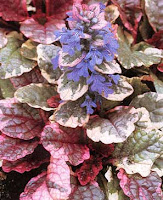These will also thrive just about anywhere.
Trudie Styler – actress, producer and director – is quoted as saying, “I have a huge belief in the importance of bees, not just for their honey, which is a healing and delicious food, but the necessity of bee colonies that are vital to the health of the planet.” Quite so.
Why bees?
Well,
because they are essential in the web of life. How could we live
without them? They contribute to the well-being of so many living
things by going about their beesness of pollinating.
Did you know that
there are over 4000 species of native bees in the United States? The
honeybee – perhaps the first that comes to mind – isn’t even
native to our continent, but was introduced. There are so many others
that are less well-known, but no less worthy.
Bees need help.
In a previous
article, I noted that bees are at a disadvantage. Loss of habitat,
mites, pesticides, wax moths, and colony collapse disorder afflict
them. They could use our help.
We can help in
various ways. I listed several before. One of the easiest is to plant
their favorite flowers.
Bees need flowers!
Flowers provide what
bees need to live. They’re not particularly picky, but seem to
prefer some flowers more than others, especially those that provide
lots of pollen and nectar. I listed five of their favorites in my
last article. Here are five more.
 Ajuga – also
known as Bugleweed, Carpenter's Herb, Sicklewort, or Middle
Comfrey – is native mostly to Europe, Asia and Africa. It’s a
low-growing ground cover that flowers in early spring with short
flower spikes in various shades of blue. Its foliage attracts the eye
even when the plant is not in bloom. The dense mat suppresses weeds,
so we like it in borders and as a lawn substitute. It grows well in
zones 3-9.
Ajuga – also
known as Bugleweed, Carpenter's Herb, Sicklewort, or Middle
Comfrey – is native mostly to Europe, Asia and Africa. It’s a
low-growing ground cover that flowers in early spring with short
flower spikes in various shades of blue. Its foliage attracts the eye
even when the plant is not in bloom. The dense mat suppresses weeds,
so we like it in borders and as a lawn substitute. It grows well in
zones 3-9.
CreepingPhlox – known as Thrift, Creeping Phlox, Moss Phlox – is superb
as a ground cover in perennial gardens and borders, rock and alpine
gardens. Of course, it is bee- and butterfly friendly. Plant it
beside terraces and between stepping stones for eye-popping color in
spring. Colors include blue, pink, lavender, white, red and striped.
Creeping Phlox is right at home anywhere in climate zones 3-9.
 Dendranthema
– familiarly known as “hardy garden mum” – is a
bright-flowered plant with blossoms shaped like large daisies. Colors
vary, but my favorite shade is pink. It’s what you might expect to
see in an English cottage garden, or around your great aunt’s back
door. Maintenance is minimal. It blooms in late summer or fall.
Dendranthema thrives in USDA climate zones 5-9.
Dendranthema
– familiarly known as “hardy garden mum” – is a
bright-flowered plant with blossoms shaped like large daisies. Colors
vary, but my favorite shade is pink. It’s what you might expect to
see in an English cottage garden, or around your great aunt’s back
door. Maintenance is minimal. It blooms in late summer or fall.
Dendranthema thrives in USDA climate zones 5-9.
Dianthus
(Cheddar Pinks) flowers look like little carnations, and smell like
them, too. These low-growing, clump forming perennials bloom spring
through summer. Evergreen, blue-green linear foliage is attractive
even when the plant is not in bloom. They’re quite easy to grow.
Dianthus performs well in climate zones 3-9.
 Sedum
(Stonecrop) attracts bees and butterflies, to the surprise of some.
Maybe they’re overlooked because sedum grows so close to the
ground. At any rate, sedum should be included in your
pollinator-friendly collection. Sedum is a remarkable ground cover
that fills cracks and crevices in rock gardens, and spills out of
containers. It grows in the most surprising places. It’ll thrive in
USDA climate zones 3-9.
Sedum
(Stonecrop) attracts bees and butterflies, to the surprise of some.
Maybe they’re overlooked because sedum grows so close to the
ground. At any rate, sedum should be included in your
pollinator-friendly collection. Sedum is a remarkable ground cover
that fills cracks and crevices in rock gardens, and spills out of
containers. It grows in the most surprising places. It’ll thrive in
USDA climate zones 3-9.Don’t fear the bee.
Fear of bees is
called melissophobia. (It sounds like a disease from a
pharmaceutical company or tort attorney’s ad.) Fact is, though,
you’re probably not so much afraid of bees as you are of bee
stings. But, take my word for it; bees are not interested in you.
They only sting in self-defense or to protect their homes. If you
leave them alone, they’d rather leave you alone.
By intentionally
planting a pollinator-friendly garden, you’ll not only be enhancing
the beauty of your space, but promoting the well-being of nature,
from the little creatures below to those that buzz above.
Return to GoGardenNow.com











